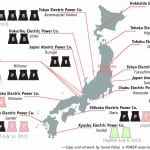More than two years after an earthquake and tsunami caused catastrophic damage at Japan’s Fukushima Daiichi Nuclear Power Station, its operator, Tokyo Electric Power Co. (TEPCO), still struggles to ensure stability at the site. In the latest unwelcome development, the site has experienced leaks of contaminated water from storage pools and is running out of space to store the radioactive water.
Roughly 400 tons of radioactive water are produced daily by the spent fuel cooling operation, and TEPCO has been storing that water on site in temporary tanks and pools. Last weekend, various media outlets reported that Japan’s Nuclear Regulation Authority (NRA) said that as much as 120 tons of radioactive water had leaked from one of the seven underground storage pools, apparently due to a failure of the pond liner. When TEPCO tried to pump the water to another pool, a second leak was discovered, though only about 3 quarts of water were released.
To date, the NRA says the leaked water is unlikely to reach the ocean, half a mile away, though some has seeped into the ground. Asia One reported that because all seven underground storage pools use the same construction, TEPCO has decided to remove the contaminated water from them and use temporary above-ground storage tanks instead.
However, on Apr. 11, TEPCO found a new leak in the No. 1 storage pool, which is where contaminated water from pool No. 2 was being transferred. That transfer was stopped. Reuters quoted General Manager Masayuki Ono as saying, "We cannot deny the fact that our faith in the underwater tanks is being lost. . . . We can’t move all the contaminated water to above ground (tanks) if we opt not to use the underground reservoirs. . . . There isn’t enough capacity and we need to use what is available."
In its latest update today on the leak situation, TEPCO said it had taken several steps that include installing temporary pumps at underground reservoirs No. 1 and No. 2 (with another planned for tomorrow at No. 3) to pump leaked water in the detection holes back to the underground reservoir. The plant operator is also drilling new observation holes to sample water in the soil for analysis.
Though TEPCO’s website has displayed a public apology and a promise of cleanup since the disaster in March 2011, patience seems to be wearing thin. Blaming slow progress and cleanup complications on “temporary equipment and rickety facilities,” an article in The Asahi Shimbun dated April 8 begins with a note of frustration about repeated equipment breakdowns (including of airborne radiation meters), human error, and the ability of a rat on March 18 to cause one of two recent blackouts that temporarily cut power to the fuel-storage cooling systems.
On April 3, TEPCO announced “disciplinary actions” as a result of the March 18 outage:
Delayed reports and public announcements as well as the long hours spent on restoration in response to the power supply failure of Units 1-4 at Fukushima Daiichi Nuclear Power Station that occurred on March 18th, 2013 has caused tremendous inconvenience and anxiety to the people of Fukushima and broader society.
Effective today, a decision has been made to implement the following disciplinary actions.
President Naomi Hirose: 5% salary cut for a one month period
Executive Vice President Zengo Aizawa: 5% salary cut for a one month period
Managing Executive Officer Akio Komori: 5% salary cut for a one month period
In addition to the above action, a severe warning will be issued to four other employees.
Disciplinary actions go further than the public apology that since the disaster has run on TEPCO’s homepage and the company’s promise to “put forth our utmost efforts into the compensation payouts, decommissioning, decontamination and revitalization of Fukushima while achieving a stable power supply and thorough business streamlining.” Alone, they are unlikely to be enough to ensure safe decommissioning and decontamination.
[This story was originally published Apr. 8. Updated Apr. 11 with current information about additional leaks.]
Sources: POWERnews, TEPCO, Wall Street Journal, Asahi Shimbun, Asia One, Reuters
—Gail Reitenbach, PhD, Managing Editor (@POWERmagazine, @GailReit)









